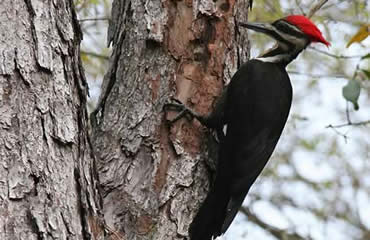By Bruce W. Todd
Being attentive is beneficial in all aspects of life, and in the outdoors, this is especially true. Students who pay attention will generally make better grades than students who write notes or daydream through class. Cooks who focus on what they are doing will be less likely to burn dinner. Drivers of vehicles must be mindful of what other drivers are doing to avoid collisions.
In the same way, those who pay attention when they go to the woods are more likely to have a successful outing.
There are several things that hunters and wildlife viewers must do to be successful. One is to be familiar with the preferred habitat and habits of the wildlife you seek. For example, you wouldn’t expect to find a wolverine in Alabama or an elk in Florida. You also wouldn’t look for a gopher tortoise in a pitcher plant bog or a groundhog in gopher tortoise territory.
Next, be self-aware and prepare yourself before you go afield.
If the animal you are in search of has a keen sense of smell, be sure to wash yourself and your clothing in odor-free soap. If the wildlife has a keen sense of sight, camouflage yourself appropriate to the environment. Be alert that noisy garments and footwear will spook your quarry.
Less obvious things also need attention. One of these is to notice the signs left in the woods. If you are in search of ground-dwelling animals like turkeys, most mammals and reptiles, you can look for tracks.
 Two animals that have a split hoof and a similar track are feral hogs and deer. Hog tracks are a little more rounded and can be easily distinguished from deer tracks with a little practice.
Two animals that have a split hoof and a similar track are feral hogs and deer. Hog tracks are a little more rounded and can be easily distinguished from deer tracks with a little practice.
Many resources are available to help you become familiar with tracks. Field guides are available at bookstores, and the internet has a wealth of information on individual species.
Some other signs besides tracks are feathers, droppings and disturbances to the environment. Evidence of the presence of a male turkey, aside from gobbling, are J-shaped droppings, breast feathers with black tips, and in the spring, scratches in the soil where male turkeys drag their wingtips along the ground in areas where they have been strutting.
Feral hog signs include rooting, wallows, and dirty rub marks on trees. Bears will turn over logs and rocks in search of grubs and insects and may leave scratch marks on the side of a tree.
You may notice the presence of bedding areas or stems of plants that have been clipped off at an angle where deer are present. Rabbits cut with upper and lower incisors leaving a stem with a straight cut.
Rabbits and deer also leave behind distinctive droppings. In the fall and winter months, buck deer will make rubs on trees and paw out scrapes to alert other deer of their presence.
Paying attention to sounds can be very important when in search of wildlife. Birds have distinctive vocalizations. A squirrel may be identified by its chattering and barking, or the sound it makes while cutting the shell off a nut or removing pine seeds from a cone.
A feral hog has a distinctive sound as it roots through the forest or gets in a scuffle with another hog. Doe deer and fawns may be heard bleating; bucks may be heard grunting, snorting and wheezing; and both may be heard blowing at those who get downwind of them.
Other forest sounds identify the presence of wildlife.
The sound of animals walking through the leaves is easily heard. You may not always be able to tell what the animal is, but with a little practice, you can distinguish squirrels and armadillos from deer.
Alarm calls are another forest sound that can help you see wildlife. Squirrels high above the ground in a tree may bark and shake their tails when they hear or see something that causes alarm. Blue jays and crows may also alert you that something or someone is approaching.
Another good alarm species is the pileated woodpecker. They seldom fail to alert you to the approach of a deer or turkey if you are paying attention.
Increasing your success in the woods is not difficult. Get to know the animals you wish to see. Prepare yourself for an outing to the fields and woodlands. Pay attention to the signs you can see and the sounds animals make.
Go afield at the times and during weather conditions that are preferred by your quarry. Use terrain features to break up your silhouette while moving or sitting, and be aware of wind direction. If you will pay attention to these things, it will certainly pay off.
— Contributed by Bruce W. Todd, Wildlife Biologist, Alabama Department of Conservation and Natural Resources.
— Photo Courtesy of the National Wild Turkey Federation
— Woodpecker photo courtesy of Ruth Law Ball